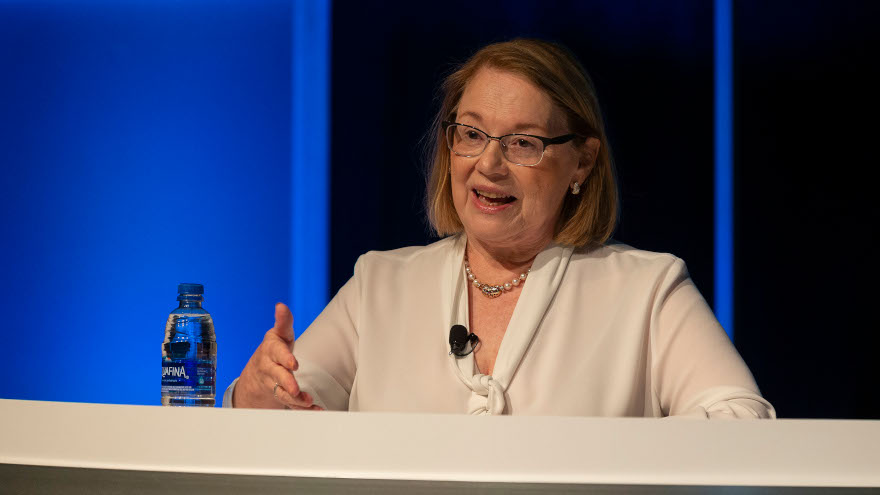Keller: Remarketing of cars becomes ‘more sophisticated’

Maryann Keller, during her presentation at the Automotive Intelligence Summit in Raleigh, N.C. Photo by Jonathan Fredin.
Increases in vehicles coming off leases. Better technology within the selling process. A more digital-first buyer. The need to manage residual risk.
It’s such phenomena as these that have led to what auto industry consultant Maryann Keller describes as “more sophisticated remarketing,” where data analysis, cost management and new sales avenues coalesce in scientific wholesale strategy.
In many ways, “remarketing has evolved,” as Keller put it during a presentation here last week at the inaugural Automotive Intelligence Summit.
Lease returns go upstream
Consider, for instance, how the influx of off-lease volumes has been managed over the past five years.
Citing data from RVI Analytics, Keller said that 28 percent of off-lease vehicles in 2013 were sold in upstream channels. But last year, almost half went that route.
“Now, that’s a big change in terms of percentages, but when you look at it in terms of absolute volume, it’s pretty staggering,” she said.
Giving some rough numbers, Keller — who is the principal of Maryann Keller & Associaties, a member of the Automotive Intelligence Council — said that five years ago, you’re talking about less than 2 million off-lease units, with around 500,000 being sold to dealers.
But with off-lease numbers approaching 4 million last year (Cox Automotive, in a recent analysis, put 2017 lease maturities at 3.5 million) and nearly half being sold upstream, Keller said the absolute volume of off-lease units being sold upstream in 2017 was more than three times as high than it was in 2013.
“The auto companies finally have taken these steps because they understand that in order to protect the value of the car and minimize the depreciation risk that they’ve already taken by subventing the lease in the first place, they have to have a more sophisticated remarketing structure that allows them to at least realize a better return on a car,” Keller said.
“It also allows them to keep the car where it is so they have no transportation costs, they have fewer fees, et cetera,” she said. “So by and large, they’re better off having done this proactively and in anticipation of the fact that they had so many off lease cars that they were going to have to be dealing with.”
Shift away from program cars
Keller, who spent more than a decade as a director with Dollar Thrifty Automotive Group before its sale to Hertz, said a similar retuning happened on the rental car side of remarketing.
During her time with DTAG, “at height of our remarketing efforts” before the sale to Hertz, Keller said that about half of their off-rental cars were sold directly to dealerships, and the team eventually learned the best approach to avoid cherry-picking by dealerships was to bundle, for example, 20 cars
Her time on the rental side also happened amid the shift away from program cars.
Until about 2007, she said, most of the rental business was in program cars, where automakers would buy back vehicles from the rental companies, meaning the OEM would take on the residual risk.
But when that shifted in 2008 — during a recession, unfortunately — and rental companies “had to actually learn how to remarket our cars successfully” and learn fleet management rapidly since they now owned vehicles and had to take on the residual risk.
‘More than a physical process’
Perhaps the most illuminating piece of insight from Keller was take on the evolution of remarketing vehicles from a process mostly dependent on physical factors to one that has a bit more science behind it.
“Back in the old days … remarketing was more of a physical process. There really wasn’t a lot of data or analysis that went into it. It was: the car was grounded, the car was marshaled, the car was sent to the auction, the car ran through the lane,” Keller said. “What happened at that point was a function of its condition, the weather, how many people were in the lane bidding. It was an entirely physical process.
“And so, it was somewhat hit-and-miss,” she said. “Clearly, supply and demand (and) a lot of other conditions influence the price, but it was thought of as a physical process.
“I think today, remarketing has evolved. It’s more than a physical process; it is a process by which you can improve the value at the end of your ownership. And people now understand that time is money, so getting that car sold fast is part of improving your overall return. Getting it in the right channel at the right time and under the right conditions.”
The digitization of the remarketing business has certainly added fuel to the fire and broadened the capabilities of remarketers in the last two decades.
There is also a “new generation of buyers who live their lives on their mobile devices” who are just fine buying cars online, Keller said.
Not to mention, there has also been an evolution in the technology that provides vehicle information — like the upgrades in photography and condition reports, Keller points out.
“So, all of these things have now converged to allow more and different channels — sometimes specific to a type of car, sometimes specific to a type of seller — to emerge quite successfully as alternatives to simply selling cars in a physical auction,” she said.
It’s no longer just about trying to get the highest price. But rather, the smallest cost, too, she said.
There are “an infinite number of options” starting to come available for remarketers, Keller said, citing examples in the rental market like rent-to-own or branded used-car sales where the remarketing, so to speak, is done via retail instead of wholesale.
But based on handfuls of presentations at the Auto Intel Summit that touched on emerging fleet management technology, alternative ownership, data science and more, the evolution may just be getting started.


